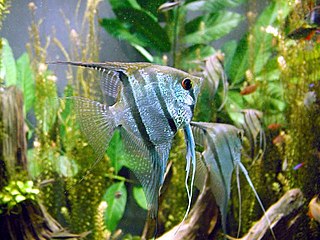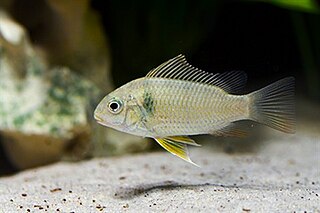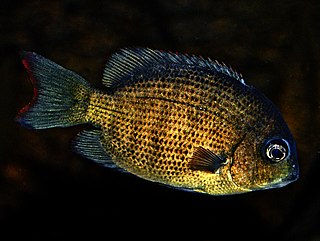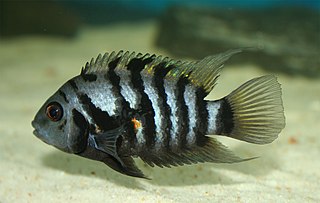
Cichlids are fish from the family Cichlidae in the order Cichliformes. Cichlids were traditionally classed in a suborder, the Labroidei, along with the wrasses (Labridae), in the order Perciformes, but molecular studies have contradicted this grouping. The closest living relative of cichlids is probably the convict blenny, and both families are classified in the 5th edition of Fishes of the World as the two families in the Cichliformes, part of the subseries Ovalentaria. This family is both large and diverse. At least 1,650 species have been scientifically described, making it one of the largest vertebrate families. New species are discovered annually, and many species remain undescribed. The actual number of species is therefore unknown, with estimates varying between 2,000 and 3,000.

Lake Tanganyika is an African Great Lake. It is the second-oldest freshwater lake in the world, the second-largest by volume, and the second-deepest, in all cases after Lake Baikal in Siberia. It is the world's longest freshwater lake. The lake is shared among four countries—Tanzania, the Democratic Republic of the Congo (DRC), Burundi, and Zambia, with Tanzania (46%) and DRC (40%) possessing the majority of the lake. It drains into the Congo River system and ultimately into the Atlantic Ocean.

Maylandia or Metriaclima is a genus of haplochromine cichlids endemic to Lake Malawi in East Africa. They belong to the mbuna (rock-dwelling) haplochromines.

Etroplus is a small genus of cichlids native to southern India and Sri Lanka. Together with Pseudetroplus, they are the only ciclids of this region.

Nandopsis is a small genus of cichlid fishes found in lakes, streams and rivers in Cuba and Hispaniola. Nandopsis are the only cichlids native to the Antilles.

Etia nguti is a species of cichlid fish endemic to Cameroon in Central Africa where it is only known from the Nguti River, a tributary of the Cross-Manyu River. This species can reach up to 13.3 centimetres (5.2 in) in standard length. It is the only member of its genus and tribe.

The orange chromide is a species of cichlid fish that is endemic to freshwater and brackish streams, lagoons and estuaries in southern India and Sri Lanka. It is also known as pallathi in Malayalam. The species is popular with fishkeeping hobbyists, and is kept frequently in aquariums. The species is part of the family Cichlidae and is included in subfamily Etroplinae. The orange chromide reaches a length of up to 8 cm (3.1 in).

Heterochromis is a genus of cichlid fish in the order Perciformes. It is the only genus of the subfamily Heterochromidinae, and contains a single species, Heterochromis multidens, which is endemic to the Congo River Basin in Central Africa. The relationships of Heterochromis to other cichlids have long been controversial, with several morphological features suggesting that it is more closely related to American cichlids than to other African species. Molecular studies have given contradictory results. The most comprehensive analysis done to date found more support for relationship to African cichlids, but could not conclusively reject a relationship to the American clade.
Interochromis loocki is a species of cichlid endemic to Lake Tanganyika in East Africa. It is a widespread but rare species living on rocky substrates in 2–3 m (7–10 ft) of water. This species can reach a length of 10.5 centimetres (4.1 in) TL. It is currently the only known member of its genus.
Naevochromis chrysogaster is a species of cichlid endemic to Lake Malawi where it prefers areas with rocky substrates. This species has a specialized diet, feeding on the fry and larvae of other cichlids. It reaches a total length of 17.9 cm (7.0 in). This species is also seen in the aquarium trade and sometimes goes by the name Haplochromis Jack Dempsey. It is currently the only known member of the genus Naevochromis.
Oxylapia is a genus of freshwater fish in the family Cichlidae. It contains the single species Oxylapia polli, known locally as the songatana. It is an endangered species, endemic to the Marolambo Rapids in the Nosivolo River in east-central Madagascar. It is threatened by habitat loss and sedimentation caused by deforestation. The only other monotypic cichlid genus in Madagascar is Katria, and it is restricted to the same region as Oxylapia. In 2010, the Nosivolo River was designated as a Ramsar Site. The Oxylapia is the conservation flagship species for the district capital Marolambo.

Paretroplus is a genus of fishes in the cichlid family, all of which are endemic to lakes and rivers of Madagascar. The vast majority are threatened and restricted to the northwestern part of the island. Only P. polyactis is found in the southern half of Madagascar and only P. polyactis and P. gymnopreopercularis are found in eastern drainages. Most are restricted to freshwater, but at least P. polyactis and P. maromandia can also be seen in brackish habitats.

The damba is a species of cichlid.

Paretroplus menarambo is a species of cichlid fish.
Katria is a genus of freshwater fish in the cichlid family. It contains the single species Katria katria, a vulnerable species from the Mangoro and Nosivolo Rivers in east-central Madagascar, that was formerly included in the genus Ptychochromoides. The only other monotypic cichlid genus in Madagascar is Oxylapia, and it is restricted to the same region as Katria. In 2010, the Nosivolo River was designated as a Ramsar Site. The Katria reaches about 13 centimetres (5.1 in) in length.

The spotfin goby cichlid is an African species of cichlid endemic to Lake Tanganyika where it is only known from the northern end of the lake. They live amongst pebbles in the surf-zone. This species can reach a length of 7 centimetres (2.8 in) TL. This species can also be found in the aquarium trade. Although presently considered the only species in the genus, another undescribed species is known from the Lukuga River.

The green chromide is a species of cichlid fish that is native to fresh and brackish water habitats in some parts in India such as Kerala, Goa, Chilika Lake in Odisha and Sri Lanka. The species was first described by Marcus Elieser Bloch in 1790. This species and other members of the genus Etroplus are relatively closely related to the Paretroplus cichlids from Madagascar.

Amatitlania is a genus of cichlid fishes native to freshwater habitats in Central America from El Salvador and Guatemala to Panama. They are fairly small cichlids, typically reaching up to 6.4–10 cm (2.5–4 in) in standard length depending on exact species, although captives may grow larger.

Etroplinae is a subfamily in the cichlid family of fishes. The subfamily includes 3 genera : Etroplus and Pseudetroplus, which are the only cichlids native to India and Sri Lanka, and Paretroplus from Madagascar.

Jerdon's baril is a fish in the genus Barilius of the family Cyprinidae. It is found in southern Karnataka and northern Kerala.















